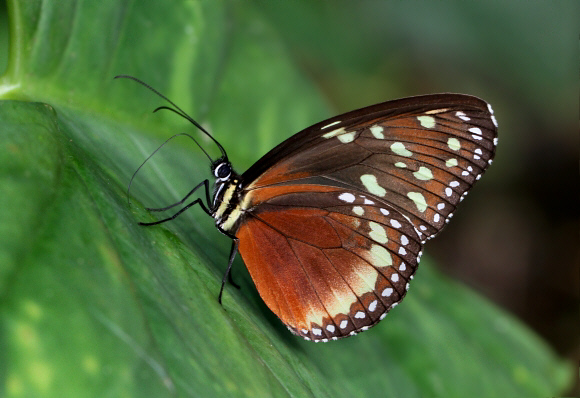
Introduction
The Ithomiini comprises of 376 known species, although it is likely that at least another 30 will be discovered in the near future. All are confined to the neotropical region. Ithomiines are unpalatable to birds, and are consequently mimicked in appearance by many other species.
These include other unpalatable species (Müllerian mimics), not only from the Ithomiinae but also from several other butterfly families. There are also a large number of edible species (Batesian mimics) which have evolved similar patterns. Birds have the ability to memorise butterfly patterns and so learn to avoid eating noxious species, but are also fooled into ignoring similarly marked edible species.
Ithomiines are characterised by having small eyes, slender abdomens and long drooping antennae that lack distinct clubs. Males have a plume of long androconial scales or ‘hair pencils’ on the costa of their hindwings. These are hidden from view when the butterflies are at rest, but are displayed when the wings are held open during courtship. Other Ithomiine characteristics include a very slow and deep wing beat, and a preference for inhabiting the darkest recesses of the forest understorey.
There are basically 2 types of Ithomiine. The first type are the black and orange-banded ‘tigers’, many of which are mimicked by other species due to their unpalatability to birds. The second type are the ‘glasswings’, recognised by their transparent or translucent wings, prominent veins, and orange wing margins. Many genera contain examples of both of these types, and in some cases an individual species may produce adults of both forms according to location.
Most novices find the Ithomiini very difficult to identify. Using only the patterns to identify species is very unreliable because there are so many similar species. Also many species produce a variety of different colour forms according to locality and season. The best approach therefore is to use the hindwing venation and other anatomical features to identify the genus, and to then look at the wing patterns to short-list the likely species.
Tithorea are large butterflies. They often fly in sunny glades where they can easily be confused with Heliconius species such as ismenius, numata or hecale. The easiest way to distinguish Tithorea from their mimics is to examine the antennae and legs.
Tithorea antennae are very gradually tapered, and drooping. In Pieridae they are parallel along the stalk, with a strongly clubbed tip, while in Papilionidae the tip is clubbed and recurved. Ithomiines, Heliconiines and Nymphalines have only 2 pairs of functioning legs. In the Ithomiines these are long, giving the impression of a butterfly on stilts. Papilionidae and Pieridae have 3 pairs of functioning legs.
Tithorea tarricina is one of the commonest and most widespread species, being found from Mexico to Bolivia. There are 9 named subspecies.
Habitats
This species inhabits rainforest and cloudforest at elevations between about 200-2000m.
Lifecycle
The larvae feed on Apocynaceae. These plants contain toxins that are ingested by the larvae and passed on to the adult butterflies, rendering them highly distasteful to birds. The larva of tarricina is green with a dark band around each segment, and has two long filaments arising from the first thoracic segment. The pupa is silvery and resembles a large water droplet.
Adult behaviour
Tithorea tarricina is usually encountered singly. In sunny weather the adults are secretive, flying in light gaps in the understorey. In overcast conditions however they emerge into more open areas along the edges of streams or wide forest tracks. They often settle on low foliage, slowly fanning their wings.
Males are attracted to bird droppings, from which they obtain pyrrolizidine alkaloids. The chemicals serve multiple purposes – they increase the toxicity of the butterfly rendering it unpalatable to birds, they are essential in the production of pheromones, and they are transferred to the female during copulation thereby increasing her longevity and fertility. Males often visit the same bird dropping on 3 or 4 successive days.
